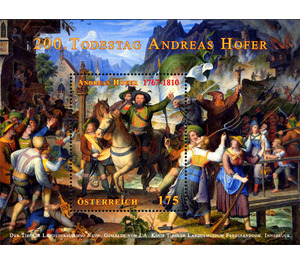200th anniversary of death Andreas Hofer - Austria / II. Republic of Austria 2010
Theme: Animals
| Country | Austria / II. Republic of Austria |
| Issue Date | 2010 |
| Edition Issued | 170,000 |
| Item Type | Block |
| Chronological Chapter | OOS-OE2 |
| Chronological Issue Number | Block 58 |
| SID | 131583 |
| In 55 Wishlists | |
Andreas Hofer (1767-1810), as a freedom fighter and leader of the Tyrolean uprising movement of 1809, undoubtedly entered the history of the country forever. The new special stamp block, which is published on the occasion of the 200th anniversary of the death of Andreas Hofer, shows the imposing painting "The Tiroler Landsturm anno neun" by Joseph Anton Koch; the original work is in the Tyrolean Landesmuseum Ferdinandeum in Innsbruck. History: After the defeat of Austria in the Third Coalition War and the Peace of Bratislava was Tyrol since 1805 under Bavarian rule. This began to enforce a series of reforms, with above all the disregard for the Tyrolean military constitution and the reintroduction of Joseph Joseph Church reform caused displeasure. Immediately after the first battle on the Bergisel there were riots against the Jewish population of Innsbruck. The forced eviction of recruits for the Bavarian Army eventually led to a rebellion that began on April 9, 1809. Andreas Hofer took the lead in the anti-Bavarian movement. Already on 11 April he was able to prevail against Sterzing against Bayern, but this (together with French troops) succeeded in bringing parts of Tyrol back under their control and retake Innsbruck. After the Bavarian-French troops had prevailed on 13 May in a bloody battle at Wörgl, it came on 25 and 29 May to two more battles on Bergisel, which had to withdraw the Bavarian troops in the end. This was followed by the Znojmo armistice with a renewed occupation of Tyrol by Napoleonic troops. The appeal to the Landsturm was followed by another victory on 13th August. 15,000 Bavarian, Saxon and French soldiers led by Marshal Lefebvre faced an equally large Tyrolean rifle squad under Andreas Hofer. The peace of Schönbrunn, which was considered a fraud in Tyrol, again motivated Hofer to revolt, which ended, however, on 1 November 1809 with the defeat of the Tyrolean Bergisel. Hofer had to flee, but was betrayed, captured and taken to Mantua, the headquarters of the French viceroy of Italy, Eugène Beauharnais. He initially wanted to spare Hofer, but Napoleon personally ordered his immediate execution. A French court martial imposed after brief trial on February 19, 1810 the predicted death sentence on Andreas Hofer, which was already enforced the next day. After the verdict, the first shots crashed, a second salvo hit Hofer in the face - the Luxembourg Michel Eiffes finally gave him the coup de grace by shooting him in the left temple. The remains of Andreas Hofer rest since 1823 in the Innsbruck Hofkirche.


